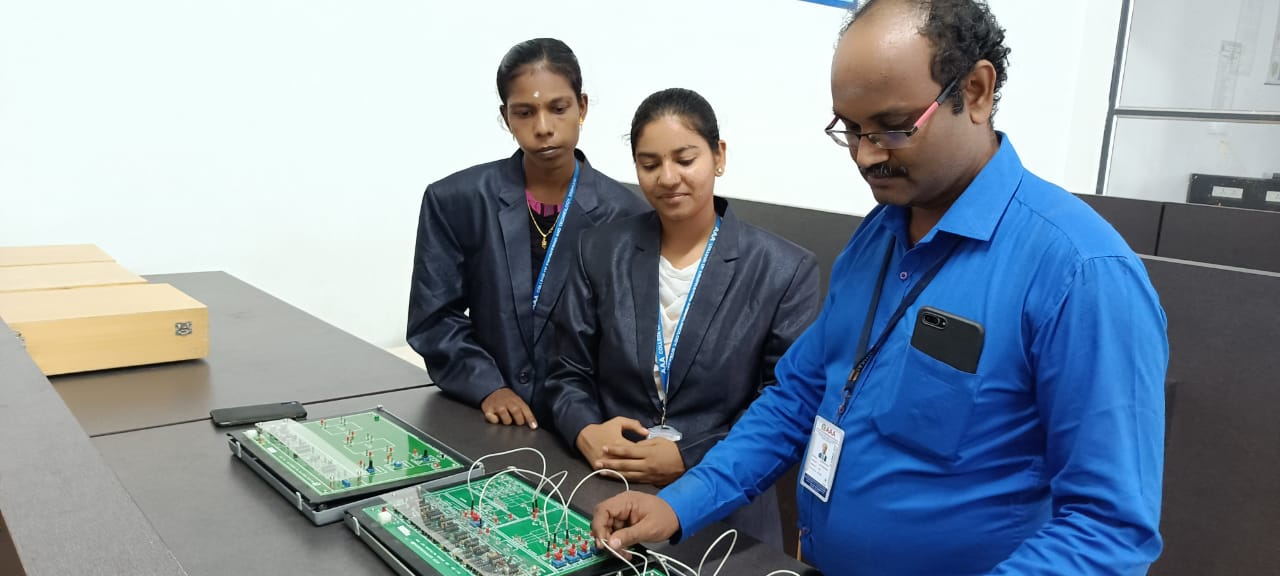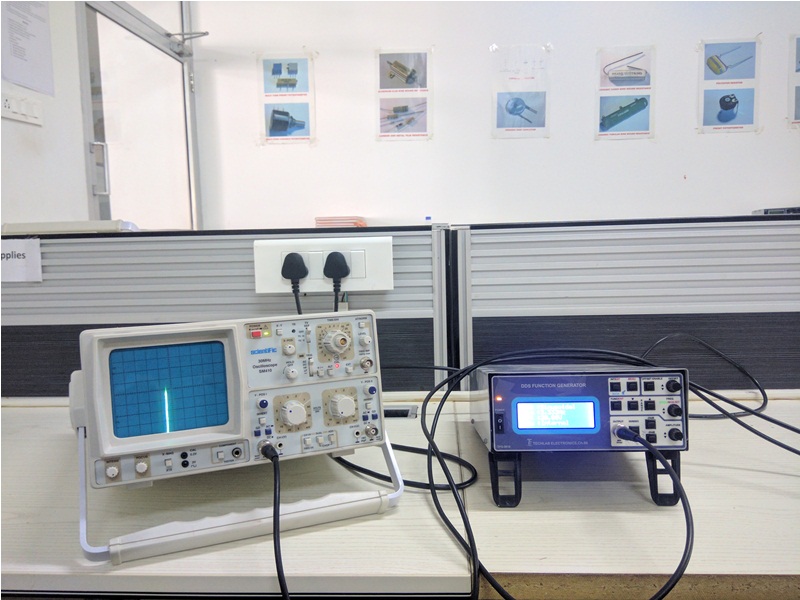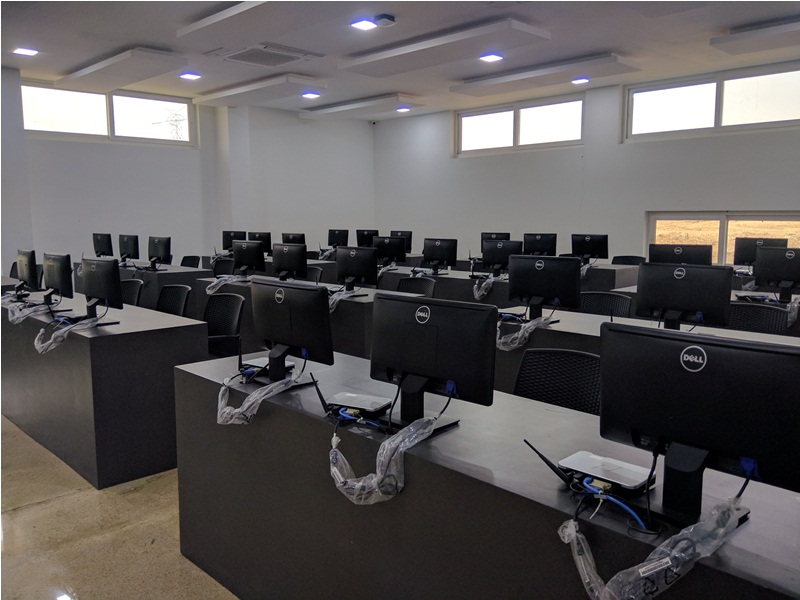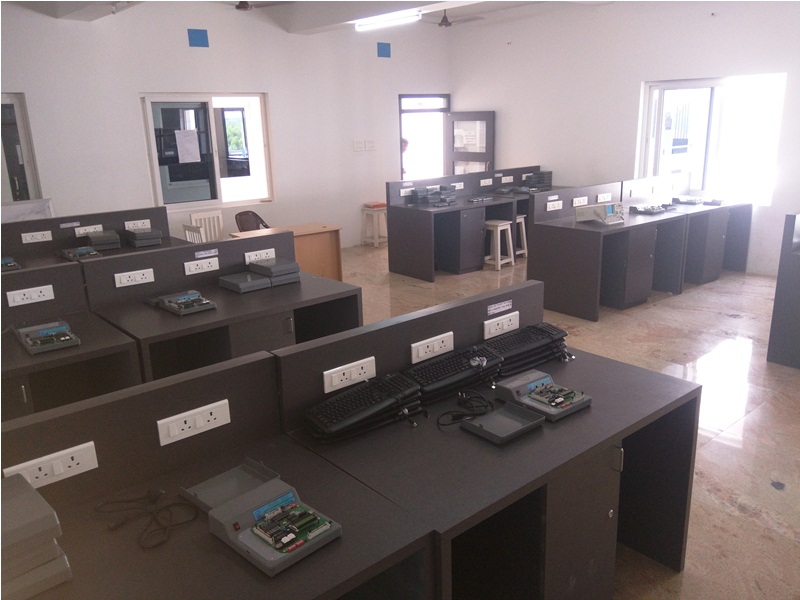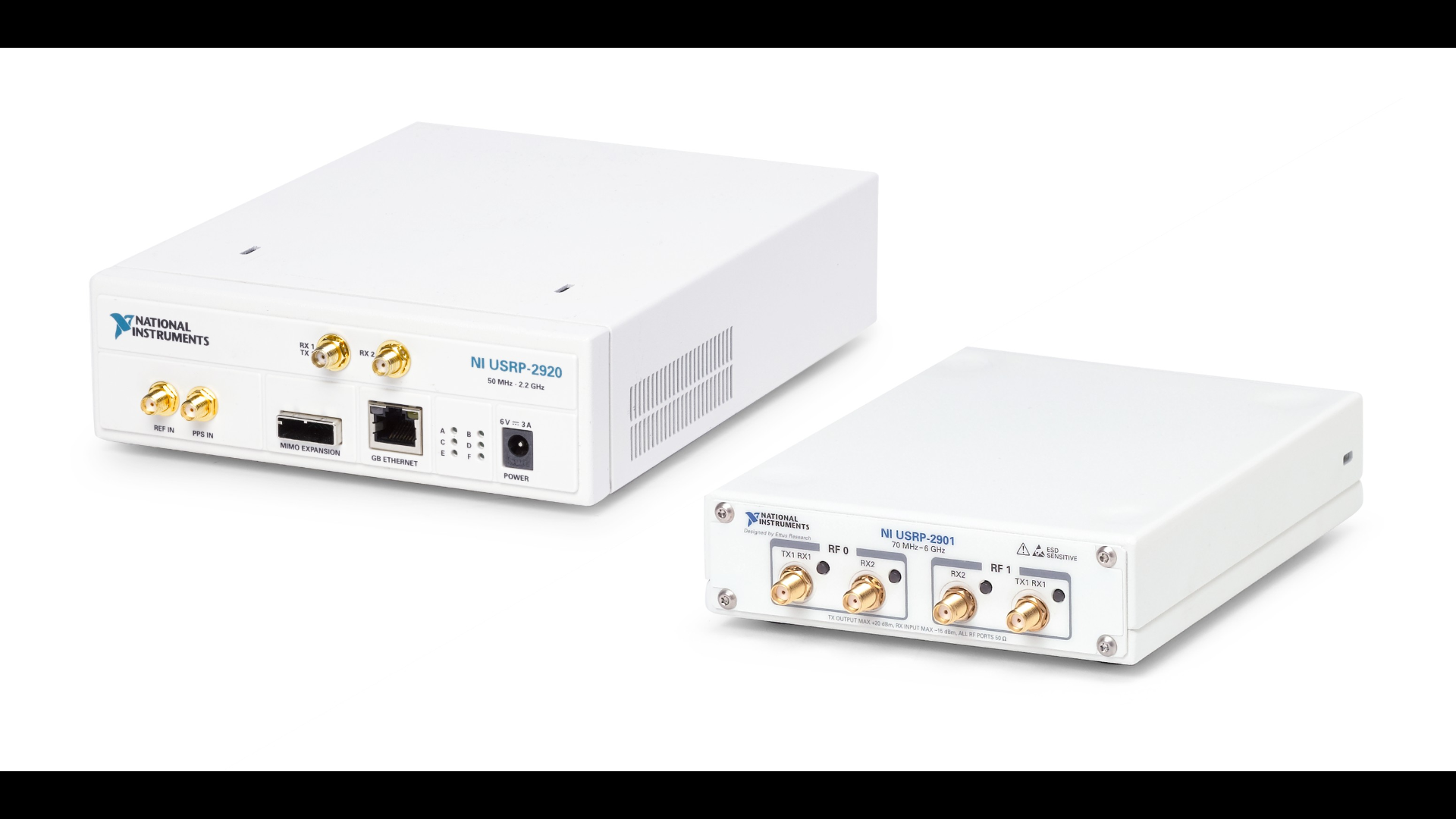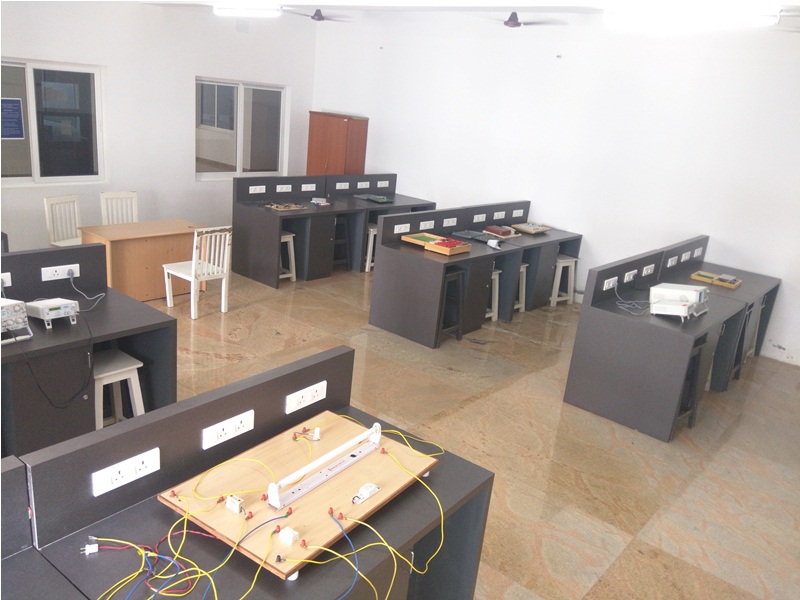Electronics and Communication Engineering
The Department of Electronics and Communication Engineering (ECE) was established in the year 2013 and offers B.E program in Electronics and Communication Engineering with an intake of 60 students. The Department of ECE is committed to providing quality professional education to young aspiring engineers. The mission of the department is to provide state of the art infrastructure and student centric learning environment to facilitate young engineers acquire profound technical knowledge in the areas of Electronics and Communication Engineering along with ethical values and leadership qualities to become as a successful professional/entrepreneur. The department has well experienced and dedicated faculty members. Several faculty members have received their graduate, postgraduate and Doctorate degrees from institutions of national and international repute and have been working on in various research areas.
The department has state of the art laboratories such as Communication lab, Advanced Microprocessor lab, Electronics circuit lab, Microwave lab, Electronics CAD lab, Devices and circuits lab, Linear Integrated Circuits Lab, Optical fiber communication lab, and VLSI lab to provide the students with the necessary and sufficient backing of practical knowledge, besides encouraging them to carry out their innovative research and development ideas.
Apart from the Core laboratories prescribed by the Anna University, department also has E-YANTRA Robotics Laboratory and also has a Center Excellence in Industrial Internet of Things (IIOT). Certification courses are conducted by these labs/center throughout the year for ECE and other department students.
The department has consistently achieved excellent results in the university examinations and have obtained university rank in the year 2018.
The Department has signed various academic institutions and industries for imparting recent and advanced technical knowledge to the students. The department has MOU with BSNL, to provide real time training for the students in the field of advanced communications. IETE student chapter was established in ECE department and various Symposiums, Seminars and Workshops are organized through it.
Value added courses are offered to the students in areas such as Electronic circuit design using PSPICE, Image and Signal processing applications using MATLAB, VLSI circuit design using Mentor Graphics, Embedded system design using Embedded C are conducted time to time to facilitate the students to improve their creative thinking capabilities, designing and analyzing skills and also create awareness in the technologies which are currently used in the industries.
Vocational courses in different areas such as Health and Safety measurements, ECAD-Electronic Computer Aided Design, Combinational and Sequential logic, Advanced Digital System Design, Electrical and Electronics measurement of Testing, Radio Communication, Principles and applications of Microcontroller, Programmable Logic Controller and on various other topics as per the student’s needs.
Apart from the above, Experts from the industry are periodically invited to give lectures/demonstrations to the students on the latest developments in the field. Students are given exposure to industries by industrial visits and industrial training session.
To make the students industry ready, Soft skill training is imparted to the students along with the technical courses from the first semester onwards. Various reputed companies visit the department every year for on-campus placement drives and department holds a placement record of more than 90%
Vision
- To be a premier engineering department in the field of Electronics and Communication Engineering by imparting quality education, carrying out innovative research and technology development according to the global industrial standards for the well-being of the society.
Mission
- To provide eminent faculties and establish a unique student centric learning environment, inculcate profound knowledge in the frontier areas of science and technology with the state of art technologies.
- To provide ethical and value-based education in developing research expertise, professional attitude and leadership qualities.
- To promote student’s technical skills in solving complex electronics and communication engineering problems and provide a platform for promoting collaborative and multidisciplinary research activities.
Program Specific Outcomes (PSOs)
- Ability to apply the basic and fundamental knowledge to identify, formulate and solve real-time problems in the field of electronics and communication engineering.
- Ability to comprehend and demonstrate the technical competency in the usage of modern software/hardware tools to design, analyze, synthesis and validation of components, subsystems and processes in VLSI, Signal Processing and Embedded control Systems.
- Ability to apply domain knowledge to carry out innovative projects with ethical and professional constraints leading to a successful career.
Program Educational Objectives (PEOs)
- Graduates have profound knowledge in the field of electronics and communication engineering and have successful career in industry or by pursuing higher education and research or by becoming as an entrepreneur.
- Graduates demonstrate their technical competency and problem-solving skills in developing innovative, economic and environmentally feasible engineering solutions for multi-disciplinary applications and societal needs.
- Graduates possess leadership qualities and ethical attitude to work efficiently with diverse teams, adapt to recent technology trends by engaging in lifelong learning and participating in research and development.
|
Course Code &Name |
Course Outcome No. |
Course Outcomes |
|
SEMESTER – I |
||
|
After completion of the course, the students will be able to |
||
|
HS8151 & Communicative English |
1 |
Build listening skills to acknowledge formal and informal conversations |
|
2 |
Illustrate the various kinds of Grammar in speaking etiquette |
|
|
3 |
Describe the narrative techniques in Communication |
|
|
4 |
Interpret writings and formulate simple sentences in English |
|
|
5 |
Classify the main and sub-ordinate ideas in writing |
|
|
MA8151 & Engineering Mathematics – I |
1 |
Apply limits and differentiation to differentiate functions and solve maxima and minima problems. |
|
2 |
Evaluate integrals using Riemann sums and Fundamental Theorem of Calculus. |
|
|
3 |
Apply integration to compute multiple integrals, area, volume, integrals in polar coordinates, in addition to change of order and change of variables |
|
|
4 |
Evaluate integrals by using techniques of integration, such as substitution, partial fractions and integration by parts |
|
|
5 |
Determine convergence/divergence of improper integrals and evaluate convergent improper integrals. Apply various techniques in solving differential equations |
|
|
PH8151 & Engineering Physics |
1 |
Describe the fundamentals of properties of matter to formulate and analyze the problems in columns and beams. |
|
2 |
Summarize the concepts and applications of waves, lasers and fiber optics to give theoretical approaches to design modern devices. |
|
|
3 |
Identify the thermal properties of materials required for expansion joints and heat exchangers and determine the heat flow. |
|
|
4 |
Explain the concepts of advanced quantum theory and its applications in tunneling microscopes for both the mathematical and physical prediction. |
|
|
5 |
Explain the basics of crystals, their structures and different crystal growth techniques to understand the behavior of the solids. |
|
|
CY8151 & Engineering Chemistry |
1 |
Illustrate the methods of water softening, requirements of boiler feed water and water treatment methods. |
|
2 |
Explain catalysis theories and adsorption concepts used in pollution abatement. |
|
|
3 |
Identify the eutectic mixtures of suitable alloys for the replacement of traditional materials in Engineering applications. |
|
|
4 |
Describe methods of fuel manufacture and calculation of calorific value to meet desired needs within realistic constraints. |
|
|
5 |
Explain the principle and generation of energy in batteries, nuclear reactors, solar cells, wind mills and fuel cells to give an idea about various energy sources and storage devices. |
|
|
GE8151 & Problem Solving and Python Programming |
1 |
Develop algorithmic solutions to simple computational problems |
|
2 |
Read, write, execute simple Python programs. |
|
|
3 |
Develop simple Python programs for solving problems and decompose them into functions |
|
|
4 |
Represent compound data using Python lists, tuples, dictionaries |
|
|
5 |
Describe the methods to read and write data from/to files in python programs |
|
|
GE8152 & Engineering Graphics |
1 |
Construct multiple views of objects and conic sections. |
|
2 |
Construct orthographic projections of lines and plane surfaces. |
|
|
3 |
Outline projections of solids. |
|
|
4 |
Outline projections of sectional views and development of surfaces. |
|
|
5 |
Extend isometric and perspective sections of simple solids. |
|
|
GE8161 & Problem Solving and Python Programming Laboratory |
1 |
Solve simple computational problems using python programs |
|
2 |
Solve problems using conditions & loops in python |
|
|
3 |
Develop Python programs by defining functions and calling them |
|
|
4 |
Apply python list, tuples and dictionaries for representing compound data |
|
|
5 |
Develop python programs using files |
|
|
BS8161 & Physics and Chemistry Laboratory |
1 |
Demonstrate the basic concepts like torque , elasticity and bending moment of beams for various engineering applications by the determination of rigidity modulus of the wire and young’s modulus of the material of the beam by non-uniform bending. |
|
2 |
Identify the fundamentals of thermal properties of material of the bad conductor by Lee’s disc method. |
|
|
3 |
Demonstrate the estimation of DO content in water sample by Winkler’s method and molecular weight of polymer by Ostwald viscometer |
|
|
4 |
Determine the strength of an acid using pH meter and conductometer |
|
|
5 |
Demonstrate the estimation of weak and strong acids in a mixture by conductometer |
|
|
SEMESTER – II |
||
|
HS8251 & Technical English |
1 |
Develop the listening skill to comprehend lectures and talk in their area of specialization successfully. |
|
2 |
Improve the speaking ability to communicate effectively in varied formal and informal contexts. |
|
|
3 |
Build the reading proficiency for effective understanding of scientific and technical reports. |
|
|
4 |
Construct sentences successfully for effective writing of journal papers and job winning applications. |
|
|
5 |
Enhance communication skills for competent reporting and presenting among the engineering community. |
|
|
MA8251 & Engineering Mathematics – II |
1 |
Apply the idea of reducing complex problems into simple form using matrix technique. |
|
2 |
Apply line, surface and volume integrals using Gauss, Stokes and Green’s theorems and verify |
|
|
3 |
Apply Analytic functions, conformal mapping and complex integration to simplify complex problems |
|
|
4 |
Apply various techniques in solving complex integration problem to simple problem by using residue technique |
|
|
5 |
Apply Laplace transform and inverse Laplace transform to solve differential equations with constant coefficients |
|
|
PH8253& Physics for Electronics Engineering |
1 |
Describe the classical and quantum electron theories and energy band structures to analyze the materials for their specific applications. |
|
2 |
Explain the fundamentals of semiconductor physics used in semiconductor electronic devices such as hall devices, ohmic contacts, schottky diode and power transistor. |
|
|
3 |
Summarize the properties of magnetic and dielectric materials used in modern devices such as Magnetic hard disc, sensor and computer data storage. |
|
|
4 |
Identify the properties of optical materials in optoelectronics to describe the theoretical approaches for the design of optoelectronic devices. |
|
|
5 |
Describe the basics of quantum structures and manipulation of materials at nanometer scale in spintronics and carbon electronics. |
|
|
BE8254 & Basic Electrical and Instrumentation Engineering |
1 |
Illustrate the concept of three phase power circuits and power system |
|
2 |
Determine the open and short circuit parameters of circuit model and calculate the efficiency and voltage regulation of transformer. |
|
|
3 |
Determine the performance characteristics of DC machines based on their type of excitation. |
|
|
4 |
Describe the construction, principle of operation and performance characteristics of single-phase induction motors and special machines. |
|
|
5 |
Outline appropriate measuring instruments for given application |
|
|
EE8251&Circuit Analysis |
1 |
Solve basic electric circuits using mesh and nodal analysis. |
|
2 |
Apply network reduction techniques to solve the given DC or AC circuits. |
|
|
3 |
Analyze the transient response of RL, RC & RLC circuits using Laplace Transform technique for AC and DC inputs. |
|
|
4 |
Determine various electrical parameters in three-phase AC circuits under balanced/unbalanced conditions. |
|
|
5 |
Determine frequency response characteristics of resonance circuits and its associated parameters |
|
|
EC8252 &Electronic Devices |
1 |
Describe the V-I characteristics of various active devices. |
|
2 |
Explain the equivalence circuits of Bipolar Junction Transistor, Diodes |
|
|
3 |
Describe the Principle and working of different types of FET ,MOSFET and JFET |
|
|
4 |
Calculate the performance parameters for FET, JFET and MOSFET |
|
|
5 |
Describe the working principle of various types of Display devices like LED, LCD, Power Devices and Opto- Electronic Devices. |
|
|
GE8261 & Engineering Practices Laboratory |
1 |
Construct connections with mixed material, joining components and prepare plumbing line sketches for water treatment, sewage works and high-rise buildings |
|
2 |
Develop models and joints using sheet metal, carpentry and fitting works |
|
|
3 |
Illustrate the use of arc and gas welding to prepare joints and demonstrate basic machining, smithy and foundry operations |
|
|
4 |
Demonstrate the basic home electrical wiring work and measure the electrical quantities such as energy, current, voltage, power, power factor and resistance to earth |
|
|
5 |
Demonstrate the applications of electronics components, gates using simple circuits |
|
|
EC8261 & Circuits and Devices Laboratory |
1 |
Analyze the characteristics of different electronic devices such as Diodes, Transistors and SCR |
|
2 |
Analyze the characteristics of simple circuits like Rectifiers, Clipper and Clamper. |
|
|
3 |
Verify Thevinin Norton theorem, KVL, KCL, Super Position Theorems, Maximum power transfer & Reciprocity theorem for the simple circuit. |
|
|
4 |
Determine the Resonance Frequency of Series & Parallel RLC Circuits. |
|
|
5 |
Analyze the Transient response of RL and RC circuits |
|
|
SEMESTER – III |
||
|
MA8352&Linear Algebra and Partial Differential Equations |
1 |
Determine the linear independency for the system of linearly equation. |
|
2 |
Identify Eigen value and Eigen vector in Diagonalizability problems |
|
|
3 |
Utilize Gram-Schmidt process to solve non – trivial problems. |
|
|
4 |
Apply Fourier series techniques to solve one and two dimensional heat flow problems and one dimensional wave equations. |
|
|
5 |
Solve differential equations by using Fourier series in dynamic Analysis |
|
|
EC8393&Fundamentals of Data Structures in C |
1 |
Implement linear and non-linear data structure operations using C. |
|
2 |
Implement features of C for developing simple applications. |
|
|
3 |
Apply appropriate linear/non-linear data structure for any given data set. |
|
|
4 |
Modify data structures for a given application. |
|
|
|
5 |
Select appropriate sorting algorithm for an application and apply hashing concepts for a given problem. |
|
EC8351&Electronic Circuits I |
1 |
Design biasing circuits for BJT and JFET |
|
2 |
Design small signal BJT amplifier circuits |
|
|
3 |
Design small signal FET amplifier circuits |
|
|
4 |
Analyze the frequency response of BJT and FET amplifiers |
|
|
5 |
Design DC power supplies and regulators |
|
|
EC8352 & Signals and Systems |
1 |
Describe the properties of signals & systems |
|
2 |
Apply Fourier series, Laplace transform and Fourier transform for analyzing the Continuous time systems |
|
|
3 |
Analyse the continuous time LTI systems using Fourier and Laplace Transforms |
|
|
4 |
Apply Fourier transform and Z transform for analyzing the LTI Discrete Time Systems |
|
|
5 |
Analyse the discrete time LTI systems using Z transform and DTFT |
|
|
EC8392&Digital Electronics |
1 |
Describe the Boolean theorems, various number systems, Karnaugh map and minimization methods |
|
2 |
Explain the operations of various combinational and the functioning |
|
|
3 |
Apply Boolean theorems and minimization techniques, state assignment for designing synchronous sequential circuits. |
|
|
4 |
Analyse cycles, races and various types of hazards in the asynchronous sequential circuits, |
|
|
5 |
Analyze various types of memory elements used in the implementation of combinational circuits |
|
|
EC8391& Control System Engineering |
1 |
Identify the various control system components and their representations. |
|
2 |
Analyze the various time domain parameters. |
|
|
3 |
Analysis the various frequency response plots and its system. |
|
|
4 |
Apply the concepts of various system stability criterions. |
|
|
5 |
Design various transfer functions of digital control system using state variable models. |
|
|
EC8381&Fundamentals of Data Structures in C Laboratory |
1 |
Write basic and advanced programs in C |
|
2 |
Implement functions and recursive functions in C |
|
|
3 |
Implement data structures using C |
|
|
4 |
Choose appropriate sorting algorithm for an application and implement it in a modularized way |
|
|
EC8361 &Analog and Digital Circuits Laboratory |
1 |
Design and test rectifiers, regulated power supplies, BJT and FET amplifiers |
|
2 |
Analyze the limitation in bandwidth of single stage and multi stage amplifier |
|
|
3 |
Calculate CMRR in differential amplifier |
|
|
4 |
Simulate and analyze amplifier circuits using PSpice |
|
|
5 |
Design and test digital logic circuits |
|
|
HS8381 & Interpersonal Skills/Listening & Speaking |
1 |
Recall to respond appropriately. |
|
2 |
Relate to discourse the ideas clearly. |
|
|
3 |
Demonstrate effective presentation. |
|
|
4 |
Develop confidence to explain appropriately in formal and informal conversations. |
|
|
5 |
Infer contextual strategies for presentation and business interactive communication. |
|
|
SEMESTER – IV |
||
|
MA8451& Probability and Random Process |
1 |
Apply the concepts of probability and distribution to solve real life problems. |
|
2 |
Illustrate the basic concepts of one and two dimensional random variables and apply in engineering applications. |
|
|
3 |
Apply the concept random processes, Poisson process and Markov in engineering. |
|
|
4 |
Apply the concept of correlation and spectral densities in engineering problems. |
|
|
5 |
Apply various probability and random process for analyzing linear systems with random inputs |
|
|
EC 8452&Electronic Circuits II |
1 |
Describe the concept of feedback and stability in amplifiers, |
|
2 |
Explain the operation for different types of Oscillators circuits |
|
|
3 |
Illustrate the various types of tuned amplifiers and stability of tuned amplifiers |
|
|
4 |
Analyze the various types of Waveshaping circuits and Multivibrators. |
|
|
5 |
Design various type of power amplifiers and DC converters |
|
|
EC 8491&Communication Theory |
1 |
Explain AM communication systems. |
|
2 |
Construct an Angle modulated communication systems |
|
|
3 |
Apply the concepts of Random Process to the design of Communication systems. |
|
|
4 |
Analyze the noise performance of AM and FM systems. |
|
|
5 |
Explain the sampling, quantization and various digital modulation techniques |
|
|
EC 8451 &Electro Magnetic Fields |
1 |
Apply vector calculus to understand different concepts of Electromagnetic Fields. |
|
2 |
Summarize the Electrostatic laws and the behavior of electric fields in matter. |
|
|
3 |
Describe the concepts of magneto statics and magnetic properties of matter. |
|
|
4 |
Apply Maxwell’s equations to obtain Wave equation. |
|
|
5 |
Explain electromagnetic wave propagation in lossy and in lossless media. |
|
|
EC8453 &Linear Integrated Circuits |
1 |
Design linear and non linear applications of op – amps |
|
2 |
Construct different types of amplifier circuits using op-amp for different applications |
|
|
3 |
Design various types of analog multipliers and PLL |
|
|
4 |
Design ADC and DAC using different techniques |
|
|
5 |
Analyze various types of waveform generators and special function IC’s |
|
|
GE8291 &Environmental Science and Engineering |
1 |
Describe the various types of eco systems and bio diversity |
|
2 |
Explain the causes, effects and control measures of different types of environmental pollution |
|
|
3 |
Describe the various types of natural resources available for human |
|
|
4 |
Explain about the various social issues related to the environment, prevention and public awareness |
|
|
5 |
Analyse the effects of human population and role of information technology in environment and human health, |
|
|
EC8461 & Circuit Design and Simulation Laboratory |
1 |
Determine the Gain of various types of feedback amplifiers. |
|
2 |
Determine the frequency response of Tuned Amplifier. |
|
|
3 |
Design and analyze Wave-shaping circuits. |
|
|
4 |
Implement the different Multivibrator circuits using transistors |
|
|
5 |
Design and simulate feedback amplifiers, oscillators, tuned amplifiers, wave-shaping circuits and multivibrators using SPICE Tool. |
|
|
EC8462&Linear Integrated Circuits Laboratory |
1 |
Design oscillators and amplifiers using operational amplifiers |
|
2 |
Design filters using Opamp and perform experiment on frequency response. |
|
|
3 |
Analyse the working of PLL and use PLL as frequency multiplier. |
|
|
4 |
Design DC power supply using IC’s. |
|
|
5 |
Analyse the performance of oscillators and multivibrators using SPICE. |
|
|
SEMESTER -V |
||
|
EC8501&Digital Communication |
1 |
Describe various theorems, loss and coding schemes in information theory |
|
2 |
Explain the working of waveform coding techniques and analyze their performance |
|
|
3 |
Design base band transmission and reception schemes for digital communication systems |
|
|
4 |
Analyze the different types of digital modulation schemes |
|
|
5 |
Design error control coding schemes |
|
|
EC8553 &Discrete time Signal Processing |
1 |
Interpret the transformation of discrete data between time and frequency domains and also apply mathematical tool for accelerating calculations in signal processing applications |
|
2 |
Design IIR filtering for undesired signal and learn the frequency response characteristics of IIR filter |
|
|
3 |
Design FIR filtering for undesired signal and know the linear phase response characteristics of FIR filter |
|
|
4 |
Illustrate the principle of quantization and finite word length and its effects in DTSP |
|
|
5 |
Explain the architecture of fixed and floating point digital Signal Processors |
|
|
EC8552&Computer Architecture and Organization |
1 |
Describe the basic structure and operation of digital computer |
|
2 |
Implement fixed point and floating point arithmetic operations in computer systems |
|
|
3 |
Illustrate parallel processing , pipelining, control hazards, exceptions in the processor design |
|
|
4 |
Analyze the different types of memories and its I/O organizations |
|
|
5 |
Explain hardware multithreading, multicore and shared memory processors, GPU’s and warehouse scale computers |
|
|
EC8551&Communication Networks |
1 |
Describe the various types devices and the protocols used to build different types of communication Networks |
|
2 |
Explain the various multiple access techniques and local area networks (LAN) based on IEEE standards. |
|
|
3 |
Apply various routing protocols to efficiently route the packets in the network layer of the computer networks |
|
|
4 |
Illustrate the functioning of various transport layer and application layer protocols, and its performance based on congestion control and its QoS |
|
|
5 |
Analyze the functioning of various applications such as SMTP, POP3, IMAP, MIME, HTTP, DNS and SNMP in the application layer of the computer networks. |
|
|
ORA551&Renewable Energy Sources |
1 |
Explain the physics of solar radiation. |
|
2 |
Discuss the classification of solar energy collectors and methodologies of storing solar. |
|
|
3 |
Illustrate the concepts of solar energy utilization in a useful way and applications of solar energy. |
|
|
4 |
Describe the concepts in wind energy and biomass with its economic aspects. |
|
|
5 |
Analyze in capturing and applying other forms of energy sources like geothermal, Wave, Tidal, OTEC, mini hydel energies. |
|
|
GE8077&Total Quality Management |
1 |
Describe the various aspects of quality management and customer issues. |
|
2 |
Explain the various principles in total quality management |
|
|
3 |
Describe the tools and techniques used in total quality management in manufacturing and service sector |
|
|
4 |
Explain the quality function deployment and Taguchi loss function and its performance measure in TQM |
|
|
5 |
Explain the various ISO standards used in quality management systems |
|
|
EC8561&Communication Systems Laboratory |
1 |
Implement AM, FM, PCM and Delta modulation and demodulation techniques. |
|
2 |
|
|
|
3 |
Simulate various digital modulation techniques such as FSK, PSK and DPSK schemes using software Programming. |
|
|
4 |
Apply various channel coding schemes & demonstrate their capabilities towards the improvement of the noise performance of communication system. |
|
|
5 |
Implement Time division multiplexing, Signal Sampling and reconstruction using trainer kits. |
|
|
EC8562&Digital Signal Processing Laboratory |
1 |
Represent various types of continuous and discrete time signals using a software. |
|
2 |
Demonstrate the characteristics of a DSP system using a Software. |
|
|
3 |
Analyze a continuous and discrete time signals |
|
|
4 |
Design and Implement the FIR and IIR Filters in DSP Processor for performing filtering operation over real-time signals |
|
|
5 |
Design a Digital Signal Processor system for various applications of Digital Signal Processing |
|
|
EC8563& Communication Networks Laboratory |
1 |
Implement Error Detection / Error Correction Techniques and Encryption and Decryption Algorithms using any programming language. |
|
2 |
Implement High Level Data Link Control and various data link layer protocols using C programming. |
|
|
3 |
Analyse performance of network with CSMA / CA protocol and compare with CSMA/CD protocols. |
|
|
4 |
Implement IP Commands such as ping, Traceroute, nslookup and various routing protocols using |
|
|
5 |
Implement various network topologies and IP address configuration. |
|
|
SEMESTER –VI |
||
|
EC8691&Microprocessors and Microcontrollers |
1 |
Describe the architecture and assembly language programming in 8086 Microprocessor |
|
2 |
Explain the basic 8086 configuration and system design using 8086 |
|
|
3 |
Illustrate the I/O and various interfaces used in 8086 |
|
|
4 |
Describe the architecture and assembly language programming in 8051 Microcontroller |
|
|
5 |
Design and implement 8051 microcontroller based systems and comparing with PIC and ARM processor |
|
|
EC8095 &VLSI Design |
1 |
Explain the basics of CMOS circuits and the CMOS process technology. |
|
2 |
Construct and analysis of combinational logic circuits. |
|
|
3 |
Design and construct Sequential Circuits and Timing systems. |
|
|
4 |
Design arithmetic building blocks and memory subsystems. |
|
|
5 |
Apply and implement FPGA design flow and testing. |
|
|
EC8652&Wireless Communication |
1 |
Describe the various parameters associated with wireless communication, its architecture and various path loss models. |
|
2 |
Explain different types of multiple access techniques, capacity and capacity improvement in wireless communication |
|
|
3 |
Illustrate the different types of digital modulation schemes and its error performance in fading channels. |
|
|
4 |
Illustrate the various equalization and diversity techniques in wireless communication for improving its performance |
|
|
5 |
Analyze the performance of MIMO based smart antenna system for high rate wireless communications |
|
|
MG8591&Principles of Management |
1 |
Discuss the evolution of management, functions and roles of managers. |
|
2 |
Explain the different types of plans, Steps in planning process and tools used for planning. |
|
|
3 |
Elaborate different organization structures and functions of human resources manager. |
|
|
4 |
Interpret the concepts in motivation techniques, leadership and communication processes. |
|
|
5 |
Describe the control techniques and the role of technology in management. |
|
|
EC8651&Transmission Lines and RF Systems |
1 |
Explain the characteristics of transmission lines and its losses. |
|
2 |
Describe about the standing wave ratio and input impedance in high frequency transmission lines. |
|
|
3 |
Analyze impedance matching in high frequency lines by stubs using smith charts. |
|
|
4 |
Analyze the characteristics of TE and TM waves. |
|
|
5 |
Discuss about RF System Design Concepts. |
|
|
GE8075&Intellectual Property Rights |
1 |
Describe the concepts and need of intellectual property related to patents, copy rights and geographical indications |
|
2 |
Explain the registration process of copy rights, trade marks, patents, geographical indications and trade secrets |
|
|
3 |
Analyze the various international treaties and conventions on IPRs |
|
|
4 |
Illustrate the IPR, cyber law and digital content protection using case studies |
|
|
5 |
Analyze various issues in IPR such as infringement of IPR’s and enforcement measures using case studies |
|
|
EC8681&Microprocessor and Microcontroller Laboratory |
1 |
Write an ALP Programs for fixed, Floating Point and Arithmetic operations. |
|
2 |
Interface different I/O’s with processor. |
|
|
3 |
Design various waveforms using Microprocessors. |
|
|
4 |
Implement and Execute various Programs in 8051. |
|
|
5 |
Implement Code conversion, decimal arithmetic and Matrix operations using microprocessor. |
|
|
EC8661 &VLSI Design Laboratory |
1 |
Develop the HDL code for basic as well as advanced digital integrated circuits. |
|
2 |
Develop the logic modules into FPGA Boards. |
|
|
3 |
Perform the Synthesization, Place and Route the digital IPs. |
|
|
4 |
Design, Simulate and Extract the layouts of Analog IC Blocks using EDA tools. |
|
|
5 |
Design and Simulate the modern chip manufacturing using software tools. |
|
|
HS8581 & Professional Communication |
1 |
Relate effective presentations and explain confidently in Group discussions |
|
2 |
Recall and interpret the current affairs |
|
|
3 |
Analyze the interview techniques and elucidate to win |
|
|
4 |
Build adequate soft skills required for the workplace. |
|
|
5 |
Make use of time management construct long term career plan. |
|
|
EC8611 &Technical Seminar |
1 |
Analyze a current topic of professional interest and present it before an expert. |
|
2 |
Identify an Engineering Problem, analyze it and propose a work plan to solve it. |
|
|
3 |
Enhance communication skills for competent reporting and presenting among the engineering community. |
|
|
4 |
Build the reading proficiency for effective understanding of technical reports. |
|
|
SEMESTER –VII |
||
|
EC8701&Antennas and Microwave Engineering |
1 |
Describe the various parameters of microwave systems and antennas |
|
2 |
Explain the radiation mechanisms and design aspects of different types of antennas |
|
|
3 |
Illustrate the various types of antenna arrays and smart antennas |
|
|
4 |
Analyze the different types of active and passive microwave devices |
|
|
5 |
Design Frequency independent antennas, Microwave Filters , Microwave Power amplifier and Microwave Oscillator |
|
|
EC8751&Optical Communication |
1 |
Illustrate the basic elements of optical fiber transmission link, different modes of configuration. |
|
2 |
Illustrate the transmission characteristics associated with attenuation and dispersion |
|
|
3 |
Explain different optical sources and detectors with their application in optical communication system |
|
|
4 |
Explain fiber optic receiver systems, measurements and coupling techniques |
|
|
5 |
Design optical communication systems and networks |
|
|
EC8791&Embedded and Real Time Systems |
1 |
Illustrate the embedded system design process, design flows, quality assurance techniques, designing with computing platforms and performance analysis |
|
2 |
Analysis the different versions of ARM architecture and its peripherals |
|
|
3 |
Illustrate the embedded programing components, compiling techniques, optimization, validation and testing process in embedded system programming |
|
|
4 |
Illustrate the structure, fault tolerance, reliability and evaluation of real time systems |
|
|
5 |
Design multiple task, multiple processors, multi rate and distributed embedded systems |
|
|
OCH752 & Energy Technology |
1 |
Realize the need of energy conversion and learn about the Indian and World Energy Scenario and world energy use resources. |
|
2 |
Explain the types of conventional energy and energy conversion systems. |
|
|
3 |
Identify the field applications of solar energy, winds energy and Understand the Geothermal, tidal energy, its mechanism of production and its applications. |
|
|
4 |
Learn about biomass sources and develop design parameters for equipment to be used in Chemical process industries. |
|
|
5 |
Know about Energy conservation act its features and related policies other acts. |
|
|
EC8702 &Adhoc and Wireless Sensor Nertworks |
1 |
Describe the design issues in adhoc wireless networks and the fundamentals od various routing protocol |
|
2 |
Identify the different types of sensor network based on its architecture and hardware components |
|
|
3 |
Illustrate MAC layer protocols for wireless sensor networks and issues in transport layer protocol |
|
|
4 |
Analyze the wireless sensor network security requirements, issues and challenges in security |
|
|
5 |
Explain the various platforms and tools used wireless sensor networks |
|
|
GE8071& Disaster Management |
1 |
Describe in detail about the types of disasters, causes and their impact on environment and society. |
|
2 |
Explain about the assess of vulnerability and various methods of risk reduction measures as well as mitigation. |
|
|
3 |
Analyze about IPCC Scenarios in the Indian context. |
|
|
4 |
Illustrate about the hazard and vulnerability profile of India. |
|
|
5 |
Describe the damage assessment and management for various applications. |
|
|
EC8711 &Embedded Laboratory |
1 |
Develop an ALP in ARM for a specific Application using embedded-C. |
|
2 |
Develop an ALP to Interface memory, A/D and D/A convertors with ARM system. |
|
|
3 |
Analyze the interrupt performance characteristics of ARM and FPGA. |
|
|
4 |
Develop an ALP for interfacing keyboard, display, motor and sensor. |
|
|
5 |
Implement a mini project using embedded system. |
|
|
EC8761 &Advanced Communication Laboratory |
1 |
Analyze the performance of simple optical link by measurement of losses. |
|
2 |
Analyze the Eye Pattern, Pulse broadening of optical fiber and the impact on BER. |
|
|
3 |
Estimate the Wireless Channel Characteristics and Analyze the performance of Wireless Communication System. |
|
|
4 |
Estimate the various parameters and modules associated with the microwave communication.. |
|
|
5 |
Implement OFDM Signal Transmission and Reception using Software Defined Radios. |
|
|
SEMESTER –VIII |
||
|
GE8076& Professional Ethics in Engineering |
1 |
Illustrate the principles of human values |
|
2 |
Demonstrate the techniques and theories of Engineering Ethics |
|
|
3 |
Explain the codes of ethics that need to be followed by the engineers in societal context |
|
|
4 |
Summarize the concept of Safety, Responsibilities and Rights |
|
|
5 |
Explain the different Global Issues |
|
|
EC 8094 & Satellite Communication |
1 |
Describe the Satellite fundamentals and types of satellite. |
|
2 |
Explain the working of a Satellite communication system and its other subsystems. |
|
|
3 |
Illustrate the various aspects of satellite link design |
|
|
4 |
Explain the various satellite access and coding methods. |
|
|
5 |
Analyze the various applications and services provided by different types of satellites |
|
|
EC8811 & Project Work |
1 |
Demonstrate a sound technical knowledge of their selected project topic. |
|
2 |
Identification of appropriate Electronics and Communication engineering problem and its solution for the benefit of the society |
|
|
3 |
Design Hardware and associated software for providing solutions to complex Electronics and Communication engineering problems |
|
|
4 |
Analyze the performance of given Electronics/Communication related systems |
|
|
5 |
Evaluate the efficiency of the given system in terms of system parameter and optimization of the parameter. |
|
No university curriculum can adequately cover all areas of importance or relevance to make the students employable. It is important for an Higher Education Institution to supplement the curriculum to make students better prepared to meet industry needs as well as develop their own interests and aptitudes. Department of Electronics and Communication Engineering offers a wide variety of certificate courses and Vocational courses which are conducted after class hours, weekends or during semester breaks. These courses are conducted by senior faculty in the department/academic experts from other institutions/Experts from Industry and help students stand apart from the rest in the job market by adding further value to their resume. The major objectives of these value-added courses are:
- To improve employability skills of our department students.
- To bridge the Institute – Industry gaps and make students industry ready.
- To provide students an understanding about the expectations of industry and to develop their own interests and aptitudes.
- To provide an opportunity to students to develop inter-disciplinary and research skills.
Value added courses are offered to the students in areas such as
- Image and Signal processing applications using MATLAB
- Electronic circuit design using PSPICE,
- Embedded system design using Embedded C
- VLSI circuit design using Mentor Graphics,
- Arduino Programing
are conducted time to time to facilitate the students to improve their creative thinking capabilities, designing and analyzing skills and also create awareness in the technologies which are currently used in the industries
Image and Signal Processing using MATLAB
MATLAB (Matrix Laboratory) is a multi-paradigm numerical computing environment and proprietary programming language developed by MathWorks. MATLAB allows matrix manipulations, plotting of functions and data, implementation of algorithms, creation of user interfaces, and interfacing with programs written in other languages, including C, C++. Students undergo hands-on training in image and signal processing by using various tools available in MATLAB
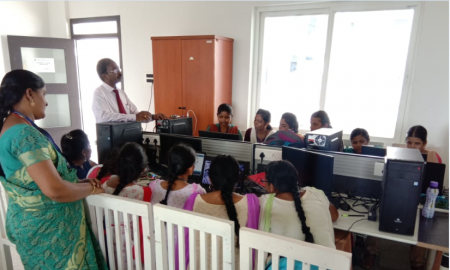
PCB Designing
PCB Designing is a mandate skill for an electrical/electronics engineer. So, students undergo PCB designing course and learn how to design a printed circuit board schematic, route traces in the PCB Layout window and create footprints and symbols for Microcontrollers like ATMEL 8051 and PIC. Printed Circuit Board design is very interesting for any electronics geek, anyone wishing to build his own PCB by themselves. It is very simple and easy to understand for beginners.
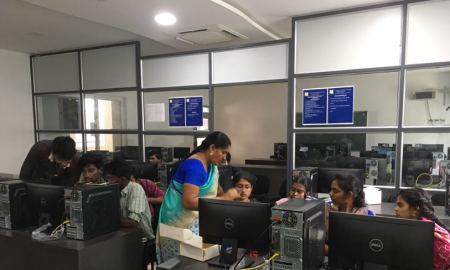
Embedded Systems
Value added course on Embedded Systems is offered to students for providing a real-world coding experience and hands on project work with ARM based Microcontrollers. Students will learn how to implement software configuration management and develop embedded software applications. Course assignments include creating a build system using the GNU Tool chain GCC and developing software in Linux on a Virtual Machine. The course concludes with a project where students will create their own build system and firmware that can manipulate memory.
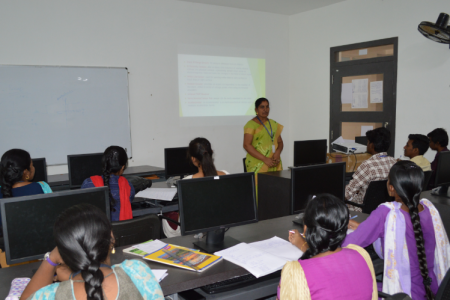
VLSI
VLSI or Very Large-Scale Integration is a way through which integrated circuit is created by integrating millions of transistors into a single chip. This design has become the most happening field of electronics and is finding its application in diverse range of electrical equipment like computer peripherals, cell phones, satellites, defense aerospace, consumer electronics, set top entertainment boxes and several other devices. VLSI design is taught to the students using MENTOR GRAPHICS software. VLSI Design Course imparts FPGA design flows, and trains the students extensively on the VLSI design methodologies, CMOS, VHDL and Verilog.
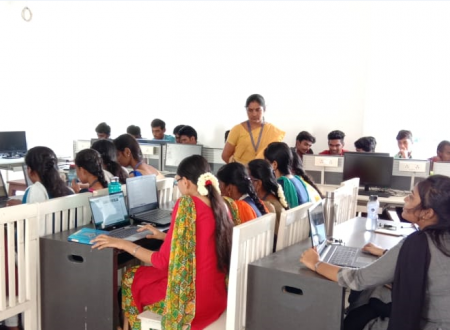
Arduino
Arduino is a small computer used to connect the physical world to the digital world. Introduced in the early 2000s as a tool for design students who had no experience in electronics programming, it has become the most popular electronics prototyping tool, especially for IoT product development. In this course students will learn about various types of sensors and interfacing methods. Also students gets hand-on experience in monitoring various sensor parameters and storing in the cloud servers and controlling various devices through Internet of Things (IOT)
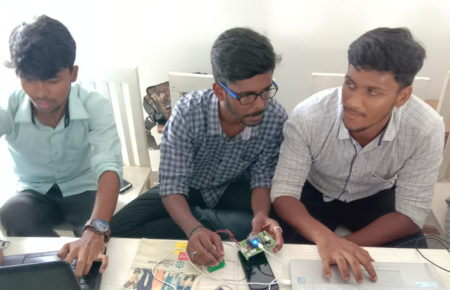
Department also has E-YANTRA Robotics Laboratory and also has a Center Excellence in Industrial Internet of Things (IIOT). Certification/Training courses are conducted as a value-added addition by these labs/center throughout the year for our ECE and other department students.
Soft Skills Training: To meet the growing Industrial demands and expectations the Department is striving hard to develop the skills of students by giving them placement training. The Placement training starts from the very beginning of the first semester itself. The Placement training includes:
- Campus Recruitment Training
- Aptitude Test Training
- Programing & Data Structures in C
- Programing in Java
- Web Technology
- English Language Lab Training
- Certified Course in Red hat
- Training in Amazon Web Services
Workshops: Apart from Value added courses for enhancing the student’s skills, numerous seminars, workshops, Hands on training sessions are conducted for our students to provide a broad overview of the numerous higher education & career options available to students after degree. Career guidance programs are also conducted to the students to assist students in identifying career options and appropriate higher education routes for each, thus enabling them determine the steps they need to take to equip themselves for their future.
All department of AAA College of Engineering & Technology organizes several programs in association with professional chapters, Industries, Academicians and Government agencies on a regular basis. The participating students and faculty enhances their knowledge and understanding of the various technological advancements brought to them in the campus through experts. For more details click the below link
ECE Activities
The Department of Electronics and Communication Engineering has been one of the core branches of Engineering. Even imagining a life bereft of electronic gadgets seems impossible in today’s world. There is no field left across the globe where one cannot find the usage of electronics and communication engineering. It has got wide application in Industries. Electronics and Communication Engineers are required in manufacturing of ICs, Embedded systems, Teleservices, Networks, Satellite Communication and all major industries and small-scale industries as well as in Government sectors like BSNL, BHEL. The Department has well developed laboratories, infrastructure and ecosystem contributing to wholesome development of the future technocrats.
The department has the following well – developed laboratories
- Communication System Laboratory
- Embedded Systems Laboratory
- Digital Signal Processing Laboratory
- Microprocessor and Microcontroller Laboratory
- Advanced Communication Laboratory
- Optical and Microwave Laboratory
- Linear Integrated Circuits Laboratory
- Electronic Devices Laboratory
FACULTY NAME LIST ACADEMIC YEAR 2022 – 2023
|
S.No |
Name |
PAN No |
Qualification |
Area of Specialization |
Designation |
Date of Joining |
Date on which (Designated as Professor/Associate Professor) |
Currently Associated (Y/N) |
Nature of Association (Regular / Contract/Adjunct) |
If contractual mention Full time or Part time |
Date of Leaving (In case Currently Associated is (“No”) |
|
1. |
Dr.S.Sevugarajan |
DVTPS5381H |
M.Sc(Engg)., Ph.D |
Instrumentation Engineering |
Professor/HoD |
01.08.2018 |
08.04.2013 |
Y |
Regular |
— |
— |
|
2. |
Dr.G.Dhanabalan |
ANTPD8423G
|
M.E., Ph.D |
Information and Communication Engineering |
Associate Professor |
16.12.2020 |
16.12.2020 |
N |
Regular |
— |
30.08.2022 |
|
3. |
Dr.T.Senthil |
AQBPS8148N |
M.E., Ph.D |
Information and Communication Engineering |
Associate Professor |
10.08.2022 |
10.08.2022 |
Y |
Regular |
— |
— |
|
4. |
Dr.B.Padmanaban |
BLNPP1425P |
M.E., Ph.D |
Information and Communication Engineering |
Associate Professor |
1.08.2022 |
1.08.2022 |
Y |
Regular |
— |
— |
|
5. |
Mrs.K.Padmapriya |
BBOPP0625C
|
M.E., |
Communication Systems |
Assistant Professor |
10.12.2014 |
— |
Y |
Regular |
— |
— |
|
6. |
Mr.C.Shanmugaraja |
CPKPS2792Q
|
M.E., |
Computer and Communication |
Assistant Professor |
23.02.2015 |
— |
Y |
Regular |
— |
— |
|
7. |
Mrs.N.Thenmoezhi |
AISPT2632H
|
M.E., |
Electronics and Communication Engineering |
Assistant Professor |
01.06.2016 |
— |
Y |
Regular |
— |
— |
|
8. |
Mr.P.Balaganesh |
BEIPB6679F
|
M.E., |
Applied Electronics |
Assistant Professor |
12.11.2020 |
— |
N |
Regular |
— |
02.05.2022 |
|
9. |
Mrs.M.Gayathri |
DBPPM7205C |
M.E., |
Communication Systems |
Assistant Professor |
01.06.2016 |
— |
N |
Regular |
— |
31.10.2022 |
|
10. |
Mr.P.Mohanraj |
DKXPP8898F
|
M.E., |
Applied Electronics |
Assistant Professor |
30.12.2020 |
— |
N |
Regular |
— |
02.08.2022 |
|
11. |
Ms.P.Arunadevi |
EIKPA7171J |
M.E., |
Communication System |
Assistant Professor |
02.08.2021 |
— |
N |
Regular |
— |
26.11.2022 |
|
12. |
Mr.D.John Elisa Deva Kumar |
AZBPJ8752G
|
M.Tech., |
Digital Communication and Network Engineering |
Assistant Professor |
18.04.2019 |
— |
Y |
Regular |
— |
— |
|
13. |
Mr.G.Jayahariprabhu |
BCJPJ2529M |
M.E., |
Communication Systems |
Assistant Professor |
02.02.2022 |
— |
Y |
Regular |
— |
— |
|
14. |
Mrs.M.Arun Devi |
BFIPA9080G |
M.E., |
Applied Electronics |
Assistant Professor |
14.03.2022 |
— |
Y |
Regular |
— |
— |
|
15. |
Mr.P.Saravanakumar |
CTJPS8234A |
M.E., |
Communication Systems |
Assistant Professor |
03.08.2022 |
— |
Y |
Regular |
— |
— |
|
16. |
Mrs.D.Suganya |
CPAPS9481Q |
M.E., |
Applied Electronics |
Assistant Professor |
01.08.2022 |
— |
Y |
Regular |
— |
— |

